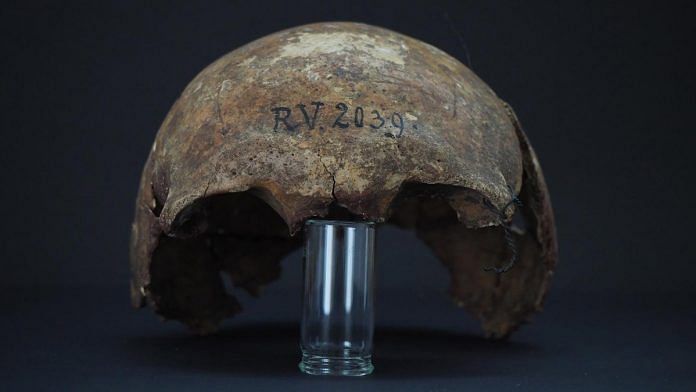New Delhi: In the 14th century, the Black Death, a deadly pandemic of the bubonic plague, wiped out as many as half of Europe’s population. However, scientists have recently discovered that a weaker and less deadly strain of the plague infected humans a couple thousand years before the pandemic hit medieval Europe.
The oldest strain of Yersinia pestis — the bacteria behind the plague — was found in the remains of a 5,000-year-old hunter-gatherer.
A genetic analysis, published in the journal Cell Reports Tuesday, found that this ancient strain was likely less contagious and not as deadly as its medieval version.
The plague-carrying hunter-gatherer was a man called ‘RV 2039’ who was between 20 to 30 years old. He was one of two people whose skeletons were excavated in the late 1800s in a region called Rinnukalns in present-day Latvia.
Two more burials were uncovered from the site in 2011, and are likely from the same group of hunter-fisher-gatherers.
The team used samples from the teeth and bone of all four hunter-gatherers to sequence their genomes and then tested them for bacterial and viral pathogens. They were surprised to find evidence of Y. pestis in RV 2039.
“What’s most astonishing is that we can push back the appearance of Y. pestis 2,000 years farther than previously published studies suggested,” said Ben Krause-Kyora, head of the Ancient DNA Laboratory at the University of Kiel in Germany, in a statement.
“It seems that we are really close to the origin of the bacteria,” he added.
Also read: A coronavirus epidemic broke out 20,000 yrs ago too & this is the impact it had on the world
How Y. pestis became deadly
After reconstructing the bacteria’s genome and comparing it to other ancient strains, the researchers determined that the Y. pestis in the fossil carried was indeed the oldest strain ever discovered.
It was likely part of a lineage that emerged about 7,000 years ago.
“What’s so surprising is that we see already in this early strain more or less the complete genetic set of Y. pestis, and only a few genes are lacking. But even a small shift in genetic settings can have a dramatic influence on virulence,” said Krause-Kyora.
This ancient strain however lacked a key gene that made the later strain of the plague that circulated in 14th century Europe so deadly.
This gene allows fleas to act as vectors to spread the plague. It was responsible for efficient transmission of the bacterium to human hosts, which resulted in the growth of the pus-filled buboes (swollen lymph nodes) in the sick that was associated with the medieval bubonic plague.
The research shows that it took more than a thousand years for Y. pestis to acquire all the mutations needed for flea-based transmission.
It is still not clear to what extent RV 2039 experienced the effects of the plague.
While the bacteria was found in his bloodstream, which means he most likely died from the infection, the researchers think the course of the disease could have been fairly slow.
The people he was buried near were not infected. RV 2039 had been carefully buried in his grave, which means that it was less likely that he had a highly contagious respiratory version of the plague.
Instead, this 5,000-year-old strain likely was transmitted directly via a bite from an infected rodent and probably didn’t spread beyond the infected person.
Also read: ‘Not that complicated’ — study has new take on India’s split from Antarctica, union with Eurasia
Theories on human civilizations challenged
The fact that the early form of Y. pestis was likely a slow-moving disease and wasn’t very transmissible challenges many theories about the development of human civilizations in Europe and Asia.
For example, some historians have suggested that infectious diseases like Y. pestis evolved mostly in megacities of over 10,000 people near the Black Sea.
However, 5,000 years ago — the age of RV 2039’s strain — was long before the formation of large cities. Instead, agriculture was just beginning to appear in Central Europe and populations were much sparser.
“We know Y. pestis most likely killed half of the European population in a short time frame, so it should have a big impact on the human genome,” said Krause-Kyora.
“But even before that, we see major turnover in our immune genes at the end of the Neolithic Age, and it could be that we were seeing a significant change in the pathogen landscape at that time as well,” he added.
(Edited by Rachel John)
Also read: Grave diggers, the frontline workers of the 1898 bubonic plague that history forgot



